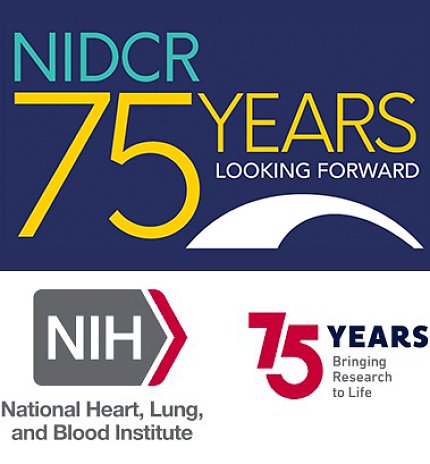The Science that Unites Us
Celebrating 75 Years of NIDCR and NHLBI Research
This year, the National Institute of Dental and Craniofacial Research (NIDCR) and the National Heart, Lung and Blood Institute (NHLBI) each celebrated 75 years of research.
To commemorate the milestones, the two institutes recently paired up to host the NHLBI and NIDCR Joint 75th Anniversary Symposium: The Science that Unites Us, which covered their notable accomplishments and areas of overlapping research.
Public Health Impact

Since its inception, NIDCR has driven research on topics such as the mouth’s microbiome, pain, head and neck cancer, tissue regeneration, craniofacial development and the biology of saliva and the salivary glands.
NIH principal deputy director Dr. Lawrence Tabak, who also is a former NIDCR director, spoke of the institute’s work toward improving quality of life. He referred to NIDCR’s early research on fluoride and tooth decay as contributing to the most successful public health campaign in U.S. history: Many people keep their teeth nowadays in part because of fluorinated drinking water.
Beyond its significant influence on public oral health, NIDCR-funded research has resulted in more than 60,000 scientific publications and 176 drugs developed to treat a whole range of systemic conditions.

“An NIDCR legacy lies in public health impact driven by basic science that serves as a foundation for clinical research, which is then translated into clinical care and improved quality of life,” said NIDCR Deputy Director Dr. Jennifer Webster-Cyriaque.
At NHLBI, numerous achievements in heart, blood, lung and sleep research have improved, lengthened and saved millions of lives. This includes public health recommendations and medications that have resulted in a 70% reduction in deaths from cardiovascular disease alone.
NHLBI’s advances in blood diseases such as sickle cell anemia and lung diseases like cystic fibrosis—once fatal childhood diseases—now allow people to live well into middle age.
“I look forward to the 100-year celebration to see how much more we can accomplish together,” said Tabak.
The Oral-Systemic Connection
Much of the overlap between NIDCR’s and NHLBI’s research lies in the oral-systemic connection— the idea that the health of the mouth affects the health of the rest of the body, and vice versa.

During the symposium, a common thread pertained to viral infections. Some viral infections such as HIV are worsened by poor oral health and periodontal disease.
“Stomach flu” viruses like norovirus typically cause uncomfortable digestive symptoms in adults and older children. However, these viruses can be life-threatening to children under 5 years old, older adults and people with weakened immune systems. Until recently, these infections were thought to spread primarily through ingestion of fecal matter particles through improper handwashing.
NHLBI Senior Investigator Dr. Nihal Altan-Bonnet presented findings on her team’s collaboration using mother-pup mice pairs to study viral spread. The team found these infections could spread through saliva and the virus in the saliva was much more infectious than the fecal matter. If the findings bear out in human studies, experts may need to modify public health recommendations to curb spread.
Multiple human papillomavirus (HPV) strains are known to increase the risk of cancer, with the HPV-16 strain most likely to cause cervical, vaginal, oral or head and neck cancers. People with weakened immune systems may be at higher risk of developing HPV-related cancers.

Dr. Gypsyamber D’Souza, professor of epidemiology at the Johns Hopkins University, and her team observed that people with HIV were more likely to have HPV infection than people without HIV. HPV infections typically take a year or two to resolve or go dormant in healthy adults. Yet among more than 1,800 people in the study, oral HPV infections took an average of four years to clear. People with HIV and persistent oral HPV infections, and particularly those infected with the HPV-16 strain, may be at highest risk for developing head and neck cancer, according to D’Souza.
Dr. Apoena De Aguiar Ribeiro, research associate professor at University of North Carolina, Chapel Hill, shared findings from an analysis of the mouth’s microbiome in people with HIV. These research participants were three times more likely to have lost all their teeth compared to the national average and were more likely to have untreated tooth decay. When it came to the mouth microbiome, Ribeiro found that inflammation and HIV infection reduced microbial diversity as well. These findings suggest that an imbalance in the microbiome may serve as a biomarker of disease severity in people with HIV.
Whole Person Health

At the Department of Health and Human Services (HHS) and NIH, clinicians are committed to caring for the whole person, not just treating a disease or a symptom, said Dr. Leith States, chief medical officer, Office of the Assistant Secretary for Health and acting director, HHS Office of Science and Medicine. However, not everyone has reaped the benefits of NIH’s medical advances discovered over the years. In a pre-recorded video, NIDCR Director Dr. Rena D’Souza said, “We must translate scientific discoveries into treatments and care that everyone can access, not just the privileged.”
NHLBI Director Dr. Gary Gibbons addressed disparities in cardiovascular health and how NHLBI is working to tackle the problem.
One example is high blood pressure in pregnancy, or preeclampsia. Black and Latina women have a two-to-four-times higher risk of developing preeclampsia than White women. Gibbons said scientists are using continuous blood pressure monitoring, artificial intelligence and machine learning to measure slight variations in blood pressure or changes in the vasculature that could be predictive of preeclampsia.
Gibbons said, “As we enhance our ability to predict, we can use more precise precision medicine to identify those at greatest risk, anticipate and reduce that risk.”



